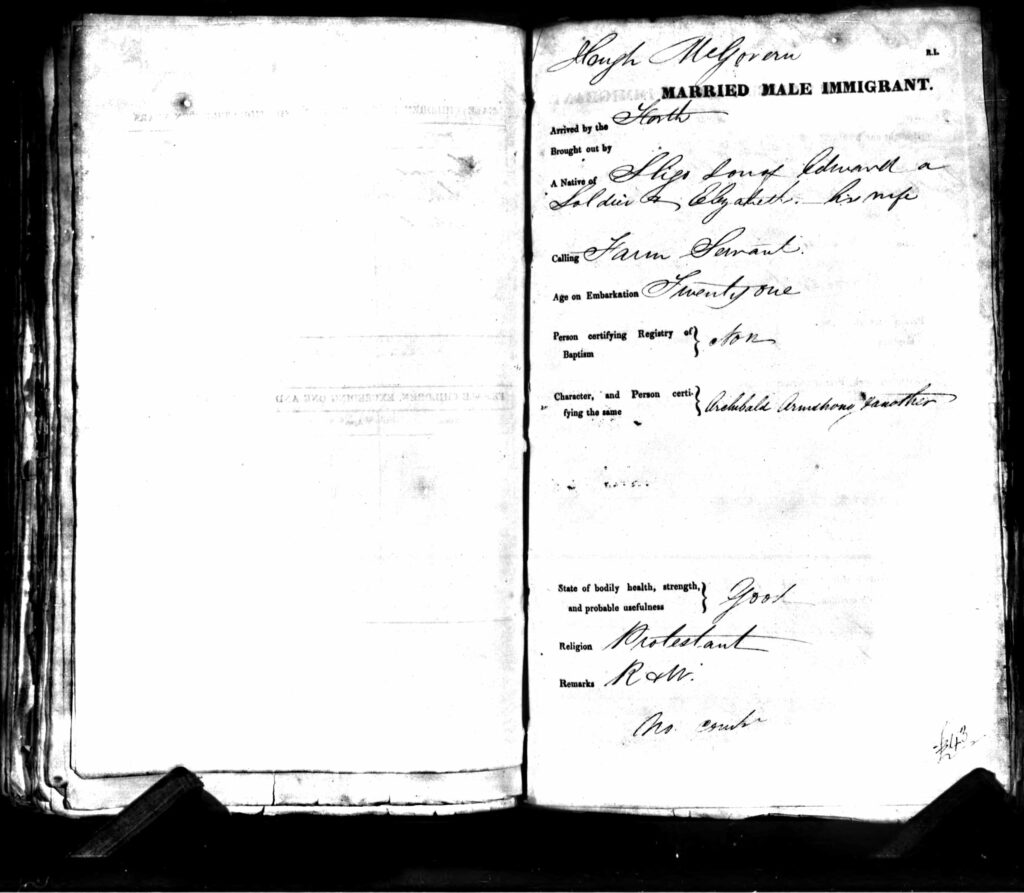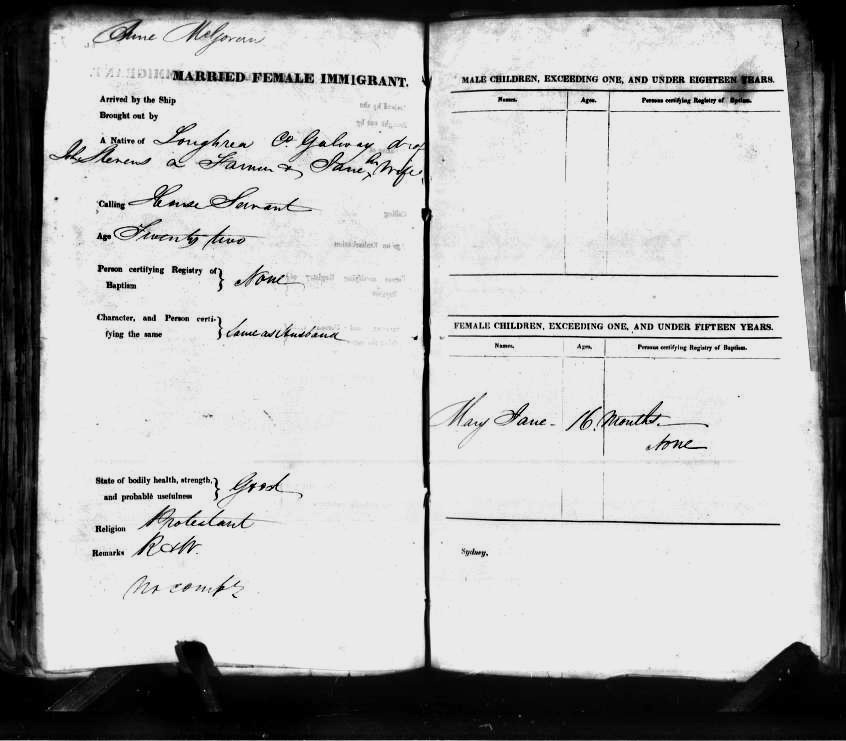Escaping Famine: Hugh McGovern (1822-1905) and Ann Stevens (1819-1873)
Life in Ireland was difficult in 1840-41, it was a time leading up to the great famine that peaked in 1845. No doubt wanting to believe the favourable tales and promises made by recruiting agents that a better life was to be found in Australia, Hugh and Ann McGovern made the decision to leave behind the hardships of life in Ireland. Being married, Protestant and able to read and write, they would have been eagerly recruited by ‘bounty’ agents tasked with replenishing the labour supply that was soon to dry up when convict transportation was ended.[1]
In May 1841 with baby Mary Jane, they joined the other 267 men, women and children and boarded The Forth, one of the new paddle steamers of the Royal Mail Steam Packet Company.[2] & [3] Their immigration records summarised the important facts for the new country. Though their ship seemed sturdy enough, they knew that travelling across the ocean would be long and dangerous. Down in steerage, close to the ocean line, where it was cramped and dark, they found the berths lined up against the side of the hull and a large dining table down the middle.

New South Wales immigration record forr Hugh McGovern onboard The Forth. Ancestry.com. New South Wales, Australia, Assisted Immigrant Passenger Lists, 1828-1896 [database on-line]. Lehi, UT, USA: Ancestry.com Operations Inc, 2007.

Ann McGovern and baby Mary Jane McGovern immigration record onboard The Forth. Ancestry.com. New South Wales, Australia, Assisted Immigrant Passenger Lists, 1828-1896 [database on-line]. Lehi, UT, USA: Ancestry.com Operations Inc, 2007.
On the journey passengers were expected to be up at seven to wash and prepare breakfasts.[4] Children of school age could attend lessons after breakfast at 8 am. After nine they began the tasks assigned to each mess, mainly scrubbing down the decks with vinegar and chloride. Water was precious, though the quality became stale after a while and worse, as rats and mice fell into the barrels and drowned and sometimes algae developed. Pickled meat, flour, sugar, dried peas and grain was stored in wooden barrels in the hold and opened as needed. By necessity they were limited to what could be prepared in large quantities, one pot style, with a little meat when available. A typical day’s fare might include oatmeal porridge, rice pudding, sea pie and pea soup.[5] Dinner was at 1pm. Afternoons were usually free time, although they couldn’t go wherever they wanted. Single men and women were kept separated and they couldn’t enter the cabin salon unless invited. Mary Jane, toddling around needed to be watched carefully. Finally, after over three months at sea, they arrived in Sydney.

‘Emigrants at dinner’. Out of copyright [London, Eng.] : Illustrated London news, April 13, 1844. nla.gov.au PIC Drawer 3971 #S2841.
Sydney, 28 August 1841
What a relief to be on solid ground again. Luckily for this voyage, apart from the usual seasickness, no serious illness broke out and only five people died. There had been lots of disputes, one fight led to a death, the culprit later being arrested.[6] Baby Mary Jane had spent about a quarter of her young life on board the ship.
But they hardly had time to take in their new surroundings, so different in many ways to their homeland, as they were unloaded and their names and details processed and with their meagre belongings, they were directed to where they were to stay until suitable positions could be found. Hopefully the agent to whom they had agreed to be bound in return for sponsoring their journey, would find a suitable position for them soon and they could then begin to set up a home.[7] With a 16 month old to care for, they needed to find employment fairly quickly.
By 1843 they had made it to Glenbrook in the Blue Mountains, 70 kilometres west of Sydney along The Great Northern Road, where their second child, Edward was born. But they didn’t stay here long. Moving northwards they arrived at Patrick’s Plains, now Singleton, about 79 km west of Newcastle and 250 km further north from Glenbrook. It was a long and arduous journey to make in those days.
Over the next ten years, Hugh and Ann worked hard to provide a home for their growing family. Six more children were born at Singleton. Although I have no evidence of this, a family story says Hugh and Ann imported Spanish white draught horses that they bred and later made quite a lot of money on by selling to Solomon Wiseman of Wiseman’s ferry, about 200 kilometres south of Singleton. It was supposedly the sale of these horses that allowed them to leave Singleton and help pioneer the district of Carroll, a small village 20 km east of Gunnedah, about 250 kilometres north-west of Singleton. [8]

Google Map notating the various places in New South Wales that Hugh & Ann McGovern and their family lived.
Their last child, Grace, was born at Carroll in 1860 who sadly died as an infant two years later. Hugh’s sons, Hubert Charles and John Shannon, now in their teens were now working.[9] Expanding his options, Hugh took over as the licensee of the Little Moulemein Hotel in Carroll in 1867.[10]
The year 1869 was a busy one for Hugh and Ann. They purchased a 40 acre property at Boomi Creek, Bingara, about 150 kilometres north of Carroll, which they named Trea-allyn. There was a two-acre property called Trevallyn owned by Townshend in the 1830s.[11] Their son Hubert married Ann Brady, whose family had settled in the area.
In 1872, John Shannon McGovern married Margaret Elizabeth O’Brien with the couple having 6 children. Hugh’s wife Ann died when she was only 54 years old on 29th November 1873. In 1878-1879, Hugh is listed as a settler in Carroll with his sons Hubert Charles and John Shannon are also listed there, Hubert would have been about 29-30 years old, and John Shannon about 32. In the 1891 census, Hugh is listed at Boomi Creek, Bingara.[12] Hugh died in January 1905 aged 82, his death was registered at Barraba, New South Wales which is about 60 kilometres south of Bingara. [13] The extended family remained in the Carroll area.
Acknowledgment: Many thanks for some background information obtained from the book- 7-up, McGovern Family, 7 Generations in Australia, Self-published for family reunion by Carin McGovern.
[1] An Australian map of British and Irish literacy in 1841, Eric Richards, Population Studies, 53 (1999) 345-359)
[2] New South Wales, Australia, Assisted Immigrants Passenger Lists, 1828-1896, Ancestry.com (Returns of convicts applications for wives and families to be bought to New South Wales at government expense, Series 1190, reel 699)
[3] The Forth was built for The Royal Mail Paddle Steam Company in Leith in 1840.
[4] The State Library of New South Wales article, Shipboard: the 19th century emigrant experience, describes life on board
[5] British food in America. Sea pie was a dish that could be assembled on sailing vessels before canning and refrigeration. It consisted of preserved meat, usually salted beef or pork, ships biscuits and little else except maybe some hard cheese or a precious onion that did not keep well in the humid conditions.
[6] Sydney Monitor 1 September 1841, Item 171919, http:freesettlerorfelon.com ‘Captain Lamb, of The Forth, immigrant ship which arrived on Saturday last has laid an information against Lawrence Dyer,one of the immigrant of that vessel, charging him with the wilful murder of another immigrant named Jantry Ryan. In June, the prisoner and the deceased were fighting when the latter received a blow on the head; the effects of which in the course of half an hour caused his death’.
[7] According to the passenger list for the Forth, Hugh and Ann McGovern’s journey was sponsored by immigration agent, Nicholas James and Company. A bounty of £38 was paid for Hugh and Ann and £5 for baby, Mary Jane
[8] Hugh and his sons, Hubert and John Shannon are listed at Carroll in the early 1860s on the Official Post Office Directory held at The Mitchell Library.
[9] Hugh, Hubert and John Shannon are listed at Carroll in the early 1860s on the Official Post Office Directory held at The Mitchell Library.
[10] 1867-1871 Hotel Government Gazette 208/1868 page 2875- from 7 Up book.
[11] 1969, W. P. Driscoll, The Beginnings of the Wine Industry in the Hunter Valley,(in association with the Newcastle and Hunter District Historical Society) Newcastle History Monographs No.5, The Council of the City of Newcastle
[12] 1891, New South Wales census
[13] 7 Up McGovern Family 7 Generations in Australia by Karen Staines. Also Australian Death Index, 1787-1985, Ancestry.co

Comments
Escaping Famine: Hugh McGovern (1822-1905) and Ann Stevens (1819-1873) — No Comments
HTML tags allowed in your comment: <a href="" title=""> <abbr title=""> <acronym title=""> <b> <blockquote cite=""> <cite> <code> <del datetime=""> <em> <i> <q cite=""> <s> <strike> <strong>